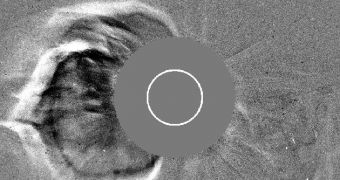Officials at NASA and the European Space Agency (ESA) are proud to announce that the Solar and Heliospheric Observatory (SOHO) has turned 15 in Earth's orbit. The spacecraft has been conducting non-stop observations of the Sun for just as many years.
The probe launched on December 2, 1995, aboard the medium-lift Atlas IIAS delivery system, and eventually made its way to the L1 Lagrangian point, where it always remains in the same position relative to the Sun-Earth-Moon system.
SOHO features a suite of 8 scientific instruments, which it uses to keep track of what goes on on the surface of the Sun 24 hours a day, seven days a week.
Its most notable contribution to science was the starting of a new field of research, called space weather, which is currently leading to a fundamental change in the way we understand the Sun.
The study of space weather refers to analyzing how everyday electromagnetic activity taking place on the star disturbs and distorts technology here Earth.
Solar flares are known to emit massive amounts of electrically-charged particles, which can fry satellites, disrupt communications, damage power grids, and endanger the lives of astronauts in space.
Among the important things SOHO accomplished, experts also include the first-ever full-time viewing experience of solar activity as it is happening. This allows us now to at least detect solar flares.
It usually takes two to three days for clouds of particles to reach Earth once they are produced, so SOHO provides us with enough forewarning to allow satellite operators to take specific measures to prevent damage to critical systems.
In other words, the space probe allows us to be prepared, potentially averting billions of dollars in damages to infrastructure, as well potential loss of human lives.
At this point, newer spacecraft, such as the NASA Solar Dynamics Observatory (SDO), carry better instrumentation, but SOHO is still an important part of Earth's defense network.
Given that other telescopes are there to take over its function, SOHO is currently being used to build up a long-term record of solar observations, which could allow experts to develop theories about how the Sun functions on the long term.

 14 DAY TRIAL //
14 DAY TRIAL //